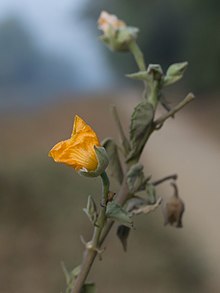Abutilon indicum
| Abutilon indicum | |
|---|---|

| |
| Scientific classification | |
| Kingdom: | Plantae |
| Clade: | Tracheophytes |
| Clade: | Angiosperms |
| Clade: | Eudicots |
| Clade: | Rosids |
| Order: | Malvales |
| Family: | Malvaceae |
| Genus: | Abutilon |
| Species: | A. indicum
|
| Binomial name | |
| Abutilon indicum | |
| Synonyms | |
|
Sida indica L. | |

Abutilon indicum (Indian abutilon, Indian mallow) is a small shrub in the family Malvaceae, native to tropic and subtropical regions and sometimes cultivated as an ornamental. It is found in Tamil Nadu.[2] This plant is often used as a medicinal plant and is considered invasive on certain tropical islands. Its roots and leaves are used for curing fever.[1]
- Tamil name: துத்தி "thuthi"
- Sanskrit name: अतिबला Atibalaa
- Telugu name: Duvvena Kayalu "duvvena benda"(దువ్వెన బెండ)
- Kannada name: TuThThi gida (ತುಥ್ಥಿ ಗಿಡ)
- Odia name: ପେଡ଼ି ପେଡ଼ିକା "Pedi Pedika" [3]
Distribution
The species occurs in a number of tropical and subtropical zones. An example occurrence is within parts of the Great Barrier Reef islands of the Coral Sea.[4]
Traditional medicine
In traditional medicine, A. indicum various parts of the plant are used as a demulcent, aphrodisiac, laxative, diuretic, sedative, astringent, expectorant, tonic, anti-inflammatory, anthelmintic, and analgesic and to treat leprosy, ulcers, headaches, gonorrhea, and bladder infection.[5] The whole plant is uprooted, dried and is powdered. In ancient days, maidens were made to consume a spoonful of this powder with a spoonful of honey, once in a day, for 6 months until the day of marriage, for safe and quick pregnancy.[6]
The plant is very much used in Siddha medicines. The root, bark, flowers, leaves and seeds are all used for medicinal purposes by Tamils.[citation needed] The leaves are used as adjunct to medicines used for pile complaints. The flowers are used to increase semen in men.[7][unreliable medical source?]

Chemistry
β-Sitosterol is present in A. indicum and a petroleum ether extract has larvicidal properties against the mosquito larvae Culex quinquefasciatus.[8] A methanol extract of A. indicum has some antimicrobial properties.[9]
References
- ^ a b "Abutilon indicum". Pacific Island Ecosystems at Risk. Retrieved 2008-06-18.
- ^ Matlwaska (2002). "Flavonoid compounds in the flowers of Abutilon indicum (Linn.) Sweet" (PDF). Acia Poloniac Pharmaceutic - Drug Research. 59 (3): 227–229.
- ^ "Archived copy". Archived from the original on 2016-12-18. Retrieved 2016-12-06.
{{cite web}}: CS1 maint: archived copy as title (link) - ^ C.Michael Hogan (2011). "Coral Sea". In P. Saundry; C.J. Cleveland (eds.). Encyclopedia of Earth. Washington DC: National Council for Science and the Environment.
- ^ Nishanta Rajakaruna; Cory S. Harris; G.H.N. Towers (2002). "Antimicrobial Activity of Plants Collected from Serpentine Outcrops in Sri Lanka" (PDF). Pharmaceutical Biology. 40 (3): 235–244. doi:10.1076/phbi.40.3.235.5825.
- ^ Pandikumar, P.; Chellappandian, M.; Mutheeswaran, S.; Ignacimuthu, S. (2011). "Consensus of local knowledge on medicinal plants among traditional healers in Mayiladumparai block of Theni District, Tamil Nadu, India". Journal of Ethnopharmacology. 134 (2): 354–362.
- ^ J.Raamachandran, "Herbs of Siddha Medicines – The First 3D Book on Herbs, p. 4[full citation needed]
- ^ A. Abdul Rahuman; Geetha Gopalakrishnan; P. Venkatesan; Kannappan Geetha (2008). "Isolation and identification of mosquito larvicidal compound from Abutilon indicum (Linn.) Sweet". Parasitology Research. 102 (5): 981–988. doi:10.1007/s00436-007-0864-5.
- ^ Jigna Parekh; Nehal Karathia; Sumitra Chanda (2006). "Screening of some traditionally used medicinal plants for potential antibacterial activity". Indian Journal of Pharmaceutical Sciences. 68 (6): 832. doi:10.4103/0250-474X.31031.
{{cite journal}}: CS1 maint: unflagged free DOI (link)
External links
- Abutilon indicum photo
- Abutilon indicum (Linn.) Sweet Medicinal Plant Images Database (School of Chinese Medicine, Hong Kong Baptist University) Template:Zh-hant Template:En icon
